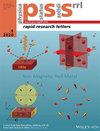Carrier transport properties of the orthorhombic phase boron nitride nanoribbons and rectifying device design
IF 2
4区 物理与天体物理
Q3 MATERIALS SCIENCE, MULTIDISCIPLINARY
引用次数: 0
Abstract
Using density functional theory combined with non‐equilibrium Green’s function, we investigate the electronic structures and carrier transport properties of the orthorhombic phase boron nitride nanoribbons (BNNRs) with different edges and different widths. The calculated results show that both armchair‐ and zigzag‐edged BNNRs are direct bandgap semiconductors. The quantum confinement gives rise to a distinct bandgap for the one‐dimensional (1D) BNNRs, and the edged atoms play an important role on their electronic structures. The bandgaps of the armchair‐edged BNNRs approach 0.5∽0.8 eV when their widths are sufficiently large. However, the electronic structures of the zigzag‐edged BNNRs exhibit more variations dependent on their edged atoms. The正交相氮化硼纳米带的载流子传输特性与整流器件设计
我们利用密度泛函理论结合非平衡格林函数,研究了具有不同边缘和不同宽度的正交相氮化硼纳米带(BNNR)的电子结构和载流子传输特性。计算结果表明,扶手边和之字边的氮化硼纳米带都是直接带隙半导体。量子约束为一维(1D)BNNR 带来了独特的带隙,而边缘原子对其电子结构起着重要作用。当其宽度足够大时,扶手边 BNNR 的带隙接近 0.5∽0.8 eV。然而,之字形边缘 BNNR 的电子结构因其边缘原子的不同而表现出更多的变化。BNNR 的 J-V 特性表明,人字形边缘 BNNR 的 J-V 性能优于扶手椅边缘 BNNR。最后,我们提出了一种实现整流行为的计算纳米器件设计方案,即在不掺杂任何掺杂剂的情况下,基于 BNNRs 构建面内异质结,左电极和右电极由不同边缘的原子构成,并在左电极上施加小应变。实现了约 77.36 的整流比。我们的研究结果提供了对正交氮化硼单层的全面理解,这将有助于其在纳米电子学中的潜在应用。本文受版权保护。
本文章由计算机程序翻译,如有差异,请以英文原文为准。
求助全文
约1分钟内获得全文
求助全文
来源期刊

Physica Status Solidi-Rapid Research Letters
物理-材料科学:综合
CiteScore
5.20
自引率
3.60%
发文量
208
审稿时长
1.4 months
期刊介绍:
Physica status solidi (RRL) - Rapid Research Letters was designed to offer extremely fast publication times and is currently one of the fastest double peer-reviewed publication media in solid state and materials physics. Average times are 11 days from submission to first editorial decision, and 12 days from acceptance to online publication. It communicates important findings with a high degree of novelty and need for express publication, as well as other results of immediate interest to the solid-state physics and materials science community. Published Letters require approval by at least two independent reviewers.
The journal covers topics such as preparation, structure and simulation of advanced materials, theoretical and experimental investigations of the atomistic and electronic structure, optical, magnetic, superconducting, ferroelectric and other properties of solids, nanostructures and low-dimensional systems as well as device applications. Rapid Research Letters particularly invites papers from interdisciplinary and emerging new areas of research.
 求助内容:
求助内容: 应助结果提醒方式:
应助结果提醒方式:


